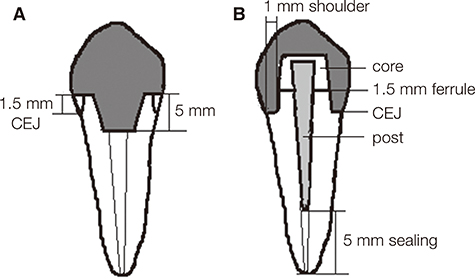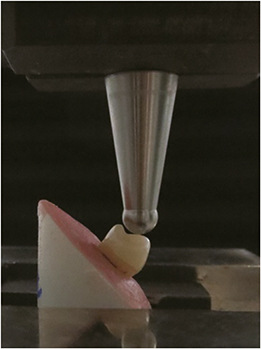J Adv Prosthodont.
2016 Dec;8(6):489-493. 10.4047/jap.2016.8.6.489.
A comparison of the fracture resistances of endodontically treated mandibular premolars restored with endocrowns and glass fiber post-core retained conventional crowns
- Affiliations
-
- 1Department of Stomatology, the Chinese PLA General Hospital, Beijing, China. hongbolli@sina.com
- 2Department of Mechanical Engineering, University of Science and Technology, Beijing, China.
- 3Department of Stomatology, the People's Hospital of Cangzhou, Hebei, China.
- KMID: 2382595
- DOI: http://doi.org/10.4047/jap.2016.8.6.489
Abstract
- PURPOSE
This in-vitro study aimed to evaluate the fracture resistances and failure modes of endodontically treated mandibular premolars restored with endocrowns and conventional post-core retained crowns.
MATERIALS AND METHODS
Thirty mandibular premolars were assigned into three groups (n=10): GI, intact teeth; GE, teeth with endocrowns; GC, teeth with conventional post-core supported crowns. Except for the teeth in group GI, all specimens were cut to 1.5 mm above the cementoenamel junction and endodontically treated. Both endocrowns and conventional crowns were fabricated from lithium-disilicate blocks using a CEREC 3D CAD/CAM unit. All specimens were subjected to thermocycling and then to 45° oblique compressive load until fracture occurred. The fracture resistance and failure mode of each specimen were recorded. Data were analyzed with one-way ANOVA and LSD Post Hoc Test (α=.05).
RESULTS
The fracture resistances of GE and GC were significantly lower than that of GI (P<.01), while no significant difference was found between GE and GC (P=.702). As of the failure mode, most of the specimens in GE and GC were unfavorable while a higher occurrence of favorable failure mode was presented in GI.
CONCLUSION
For the restoration of mandibular premolar, endocrown shows no advantage in fracture resistance when compared with the conventional method. Both of the two methods cannot rehabilitate endodontically treated teeth with the same fracture resistances that intact mandibular premolars have.
MeSH Terms
Figure
Reference
-
1. Reeh ES, Messer HH, Douglas WH. Reduction in tooth stiffness as a result of endodontic and restorative procedures. J Endod. 1989; 15:512–516.2. Huang TJ, Schilder H, Nathanson D. Effects of moisture content and endodontic treatment on some mechanical properties of human dentin. J Endod. 1992; 18:209–215.3. Linn J, Messer HH. Effect of restorative procedures on the strength of endodontically treated molars. J Endod. 1994; 20:479–485.4. Assif D, Gorfil C. Biomechanical considerations in restoring endodontically treated teeth. J Prosthet Dent. 1994; 71:565–567.5. Soares PV, Santos-Filho PC, Martins LR, Soares CJ. Influence of restorative technique on the biomechanical behavior of endodontically treated maxillary premolars. Part I: fracture resistance and fracture mode. J Prosthet Dent. 2008; 99:30–37.6. Bitter K, Kielbassa AM. Post-endodontic restorations with adhesively luted fiber-reinforced composite post systems: a review. Am J Dent. 2007; 20:353–360.7. Stern N, Hirschfeld Z. Principles of preparing endodontically treated teeth for dowel and core restorations. J Prosthet Dent. 1973; 30:162–165.8. Hirschfeld Z, Stern N. Post and core-the biomechanical aspect. Aust Dent J. 1972; 17:467–468.9. Guzy GE, Nicholls JI. In vitro comparison of intact endodontically treated teeth with and without endo-post reinforcement. J Prosthet Dent. 1979; 42:39–44.10. Sorensen JA, Engelman MJ. Effect of post adaptation on fracture resistance of endodontically treated teeth. J Prosthet Dent. 1990; 64:419–424.11. Schwartz RS, Robbins JW. Post placement and restoration of endodontically treated teeth: a literature review. J Endod. 2004; 30:289–301.12. Cheung W. A review of the management of endodontically treated teeth. Post, core and the final restoration. J Am Dent Assoc. 2005; 136:611–619.13. Sivers JE, Johnson WT. Restoration of endodontically treated teeth. Dent Clin North Am. 1992; 36:631–650.14. Gegauff AG. Effect of crown lengthening and ferrule placement on static load failure of cemented cast post-cores and crowns. J Prosthet Dent. 2000; 84:169–179.15. Biacchi GR, Basting RT. Comparison of fracture strength of endocrowns and glass fiber post-retained conventional crowns. Oper Dent. 2012; 37:130–136.16. Chang CY, Kuo JS, Lin YS, Chang YH. Fracture resistance and failure modes of CEREC endo-crowns and conventional post and core-supported CEREC crowns. J Dent Sci. 2009; 4:110–117.17. Lin CL, Chang YH, Chang CY, Pai CA, Huang SF. Finite element and Weibull analyses to estimate failure risks in the ceramic endocrown and classical crown for endodontically treated maxillary premolar. Eur J Oral Sci. 2010; 118:87–93.18. Carvalho AO, Bruzi G, Anderson RE, Maia HP, Giannini M, Magne P. Influence of Adhesive Core Buildup Designs on the Resistance of Endodontically Treated Molars Restored With Lithium Disilicate CAD/CAM Crowns. Oper Dent. 2016; 41:76–82.19. Salameh Z, Sorrentino R, Papacchini F, Ounsi HF, Tashkandi E, Goracci C, Ferrari M. Fracture resistance and failure patterns of endodontically treated mandibular molars restored using resin composite with or without translucent glass fiber posts. J Endod. 2006; 32:752–755.20. Bindl A, Mörmann WH. Clinical evaluation of adhesively placed Cerec endo-crowns after 2 years-preliminary results. J Adhes Dent. 1999; 1:255–265.21. Bernhart J, Bräuning A, Altenburger MJ, Wrbas KT. Cerec3D endocrowns--two-year clinical examination of CAD/CAM crowns for restoring endodontically treated molars. Int J Comput Dent. 2010; 13:141–154.22. Ma J, Miura H, Okada D, Yusa K. Photoelastic stress analysis of endodontically treated teeth restored with different post systems: normal and alveolar bone resorption cases. Dent Mater J. 2011; 30:806–813.
- Full Text Links
- Actions
-
Cited
- CITED
-
- Close
- Share
- Similar articles
-
- Fracture resistances of zirconia, cast Ni-Cr, and fiber-glass composite posts under all-ceramic crowns in endodontically treated premolars
- Comparison of fracture strength and pattern of endodontically treated teeth restored with fiber posts and metal cast post
- Evaluation of static fracture resistances and patterns of pulpless tooth restored with poly-ether-ketone-ketone (PEKK) post
- Fracture resistance of endodontically treated canines restored with different sizes of fiber post and all-ceramic crowns
- Fracture resistance of upper central incisors restored with different posts and cores



